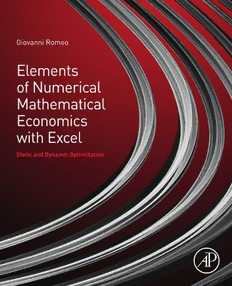Table Of ContentELEMENTS OF NUMERICAL
MATHEMATICAL ECONOMICS
WITH EXCEL
This page intentionally left blank
ELEMENTS OF
NUMERICAL
MATHEMATICAL
ECONOMICS WITH
EXCEL
STATIC AND DYNAMIC
OPTIMIZATION
G R
IOVANNI OMEO
IndependentFinancial Advisor
Academic PressisanimprintofElsevier
125 LondonWall,LondonEC2Y5AS,UnitedKingdom
525BStreet,Suite1650,SanDiego,CA92101,UnitedStates
50HampshireStreet,5thFloor,Cambridge,MA02139,UnitedStates
TheBoulevard,Langford Lane,Kidlington,OxfordOX5 1GB,UnitedKingdom
Copyright©2020ElsevierInc.Allrightsreserved.
Nopart ofthispublicationmay bereproduced ortransmitted inany formorbyanymeans, electronicor
mechanical, includingphotocopying, recording,orany informationstorageandretrieval system,without
permissioninwritingfromthepublisher.Details onhowtoseekpermission, further informationaboutthe
Publisher’spermissions policiesandourarrangementswithorganizations suchastheCopyrightClearance
CenterandtheCopyrightLicensingAgency,canbefoundatourwebsite:www.elsevier.com/permissions.
Thisbookandtheindividual contributionscontainedinitareprotected undercopyrightbythePublisher
(otherthanasmaybenotedherein).
Notices
Knowledgeandbestpracticeinthisfieldareconstantlychanging. As newresearchandexperiencebroaden
ourunderstanding, changesinresearch methods,professional practices,ormedical treatmentmay become
necessary.
Practitionersandresearchers mustalwaysrelyontheirownexperience andknowledgeinevaluatingandus-
ingany information,methods,compounds,orexperiments describedherein. Inusingsuchinformation or
methodstheyshould bemindfuloftheirown safetyandthesafetyofothers,including partiesforwhom
theyhave aprofessionalresponsibility.
Tothefullestextentofthelaw,neither thePublishernortheauthors,contributors, oreditors, assumeany li-
abilityforany injuryand/ordamagetopersonsorproperty asamatterofproductsliability,negligenceor
otherwise,or fromanyuseor operationofany methods,products,instructions, orideascontainedinthe
materialherein.
LibraryofCongressCataloging-in-Publication Data
Acatalogrecord forthisbook isavailablefromtheLibraryofCongress
BritishLibraryCataloguing-in-Publication Data
Acataloguerecord forthis bookisavailablefromtheBritishLibrary
ISBN:978-0-12-817648-1
Forinformation onallAcademic Presspublications visitourwebsite at
https://www.elsevier.com/books-and-journals
Publisher: BrianRomer
AcquisitionEditor: BrianRomer
EditorialProjectManager:DevlinPerson
ProductionProjectManager:Paul Prasad Chandramohan
CoverDesigner: Mark Rogers
TypesetbyTNQTechnologies
Contents
I 4. Mathematics for dynamic economic
models
Excel and fundamental mathematics
for economics 4.1 Ordinarydifferential equationsandnumerical
methods:EulerandRunge-Kutta 140
1. Excel VBA, solver, and other advanced 4.2 Forceofinterest, Walrasian stability, utility
worksheet tools functions,andcapitalformation withordinary
differentialequation 147
4.3 Differenceequationsandphasediagrams 159
1.1 VBAintroductionandmainstatements 3
4.4 Cobwebmodelof priceadjustment andother
1.2 TheExcelSolver:simplexLP,Generalized
economicmodels withdifference
ReducedGradient,andevolutionary 21
equations 170
1.3 What-ifanalysis: scenariomanager,GoalSeek,
4.5 Systemsof lineardifferentialequations 181
DataTable,andcontourlines 29
4.6 Tourismfightbetween twocompeting
1.4 Scatterchartsandtrendlines 40
regions 202
4.7 Walrasian adjustmentwithentry 206
2. Univariate and multivariate calculus
Exercises 209
2.1 Numericalmethodsforunivariate
differentiation 45 II
2.2 Numericalmethodsforunivariate
integration 58 Static optimization
2.3 Numericalpartialdifferentiation 66
2.4 Applicationsin economics 75
5. Classical static nonlinear optimization
Exercises 83
theory
3. Elements of linear algebra
5.1 Classical unconstrainedoptimization ofa
3.1 Built-inExcelmatrixfunctionsandbasic univariate function 220
operations 88 5.2 Classical unconstrainedoptimization ofa
3.2 Linearsystemsandresolution methodsinExcel: multivariatefunction 232
Cramer,Solver, Inverse 95 5.3 Someeconomicapplications ofthenonlinear
3.3 Eigenvaluesandeigenvectorssearch: analytical unconstrainedoptimization 247
andgraphicalapproach 107 5.4 Numericalsteepestdescentmethodappliedto
3.4 Quadraticformsanddefinitenessofasymmetric theunconstrained optimization
matrix 115 withVBA 256
3.5 Leontiefopenmodel 121 5.5 Nonlinearproblems inRnwithequality
3.6 Equilibriuminnmarkets 124 constraints:Lagrangemultipliers and
3.7 Economicpolicymodeling:objectives and Solver 264
instruments 129 5.6 Nonlinearproblems inR2withequality
Exercises 134 constraints:contourlines 272
v
vi
Contents
5.7 Nonlinearproblems withinequality 8. Nonlinear optimization applied to the
constraints 285 portfolio theory
Exercises 288
8.1 Portfolio modelingandtheefficientfrontier
6. Microeconomic theory in a static
construction 417
environment
8.2 Investor’sutilityandtheoptimalportfolio
choice 427
6.1 Theconsumerproblem:cardinalversus ordinal Exercises 432
utilityapproach 296
6.2 Consumeroptimizationandderivation of
thedemandcurveinthecardinal III
approach 297
6.3 Consumeroptimizationandderivation ofthe Dynamic optimization
demandcurvein theordinal approach 307
6.4 Thefirmproblem 319 9. Calculus of variations
6.5 One-inputclassicalproductionfunction 320
6.6 Two-inputsproductionfunctions 322
9.1 The fundamentalproblemoftheCalculusof
6.7 Isoquantsandtheconstrained production
Variations 438
optimizationwithtwoinputs 331
9.2 Discrete approximate CalculusofVariations:
6.8 ProductionEdgeworthbox,contract
Lagrangemultipliers andcontourlines
curve,andthepossibility frontier
solutions 442
construction 335
9.3 SetupoftheExcelworksheet forCalculusof
6.9 Short-run,long-runcostsandtheenvelope
Variations problems:theSolversolution 451
averagetotalcosts derivation 340
9.4 General casesdevelopedinExcelwithfixedand
6.10 Perfectcompetitive markets:short-run, long-run
variable terminal points 453
supply curvesandmarket equilibrium 350
9.5 Dynamic optimizationforamonopolist 469
6.11 Monopolistic market equilibrium:the
9.6 Unemploymentandinflation 471
Chamberlin model 356
9.7 The EisnereStrotzmodel 475
6.12 Markets withhigh-entry barriers:monopolyand
9.8 The optimalconsumptionRamseymodel 479
theCournot duopolymodel 360
9.9 Inventory dynamicoptimization 481
6.13 Game theory.Zero-sumgames and
9.10 Optimalcapital structure andthefirmcost of
minimax criterion:matrixandgraphical
capital 482
resolutions 370
9.11 Contour linessolution forCalculusofVariations
Exercises 376
usingtheVBAcode 487
9.12 CalculusofVariations withfunctionals
7. Linear programming
involving twoindependent
functions 494
7.1 Standardformulationofalinearprogram and
9.13 CalculusofVariationsconstrainedproblems 497
resolutionmethods 383
9.14 CheckingtheSecond-OrderConditions in
7.2 Applicationstothestatic productionplanning
Excel 505
andcapital budgeting 389
Exercises 511
Exercises 408
vii
Contents
10. Theory of optimal control IV
Special topics
10.1 Theoptimalcontrolproblemandthe
Pontryagin’smaximumprinciple 522
10.2 Nonlinear HamiltonianandlinearHamiltonian 12. Dynamic production planning and
(bang-bangcontrol) 523 inventory modeling
10.3 SetupoftheExcelworksheet foroptimal
controlproblems 525
12.1 Multiperiodproductionmodelswithlinear
10.4 Bang-bangcontrolproblems 542
programming 661
10.5 Consumptionmodel 547
12.2 WagnereWhitinalgorithmfor inventory
10.6 Investmentmodel 554
dynamicmodeling 669
10.7 Inventoryoptimization 561
12.3 EliezerNaddor stochasticsingle-period
10.8 Twostate variablescontrol
inventorymodels 677
problems 563
Exercises 687
10.9 Current-value Hamiltonian 571
10.10 Constraintsonthestatevariable:alinearcase 13. Data analysis for business and
withaninventoryapplication withVBA 576
economics
10.11 Steepestdescentnumerical approachfor
optimalcontrolproblems usingVBA 587
13.1 Asimplewaytoorganizeaspreadsheet using
10.12 Checkingthesufficientconditionsin
theVBA codeandbookmarks 696
Excel 593
13.2 Pivottables,Pivotcharts,anddynamic
Exercises 600
dashboardsformanagerial dataanalysis 697
11. Discrete dynamic programming 13.3 Basicdescriptivestatistics 711
13.4 Somenumerical calculus appliedtocontinuous
densities 721
11.1 Bellman’sprinciple,discrete shortestpath
13.5 Univariate,multivariateregressionanalysis and
problems,andtheExcelMINIFS
theANOVA tables 727
function 612
Exercises 756
11.2 Discretedynamicsystems:tabular method,
Exceldatatable,andSolver 619
14. Essential Monte Carlo analysis
11.3 Cargoloadingallocationproblems:tabular
methodandtheExcelSolver 629
14.1 TheMonteCarlomethodandthegeneration
11.4 Multistageallocation problemsusingtheExcel
ofrandomnumbers 764
Solver 632
14.2 TheMonteCarlomethodforbusiness
11.5 Equalityconstrained optimizationproblems
decisions 773
usingtherecursive Bellman’s approach 636
14.3 Numericalintegration 788
11.6 Dynamiceconomicproblemssolved with
Exercises 792
DiscreteDynamic Programming 639
11.7 DiscreteDynamic Programming,Optimal
Controltheory, andCalculusofVariations: a
synthesis 649 Index 797
Exercises 652
This page intentionally left blank
P A R T I
Excel and fundamental
mathematics for economics
Part I of this book aims at giving to the reader the fundamental tools of
some important advanced worksheet capabilities, including the Excel VBA,
as well as the fundamental tools of the mathematical economics applied
within a spreadsheet. These are all tools that will be needed within the
courseofthewholebookandtoolsthatanyeconomistanalystshouldmaster
within a computer language framework.
Chapter1willreviewsomeVBAcodes,whosepriorknowledgewouldbe
somehow required from the reader, in order to optimally utilize the work-
sheets that will be implemented within the book. The Excel macros used
within the book are not at a very advanced level, but still, they will require
(besidethemathematicalknowledge)acertaindegreeofVBAprogramming
language mastery.
Otheradvancedfeatures,liketheExcelSolver,thewhat-ifdatatableanalysis
(thesetwowillbeusedalotinthebook),contourdiagrams,scattercharts,and
trendlines will be introduced and then developed in detail within the book.
Chapters2e4willinsteadgivetheessentialelementsofthemathematical
economics applied with Excel.
Three important areas of the mathematical economics are covered here.
Chapter 2 will cover the essential elements of the standard calculus
(numerical differentiation and integration) applied within a spreadsheet.
Chapter 3 is dedicated to the essential elements of the linear algebra.
Chapter 4 is instead devoted to the dynamical mathematics (ordinary
differential and difference equations, as well as the systems of differential
equations). This is a chapter of paramount importance as many of the tech-
niqueswewilldevelopinthischapterwillbeusedwithinthedynamicopti-
mization section and also because the differential and difference equations
represent the key constituent area of the economic dynamic modeling.
Inallthesethreechapters,someeconomicapplicationsarealsoproposed.

